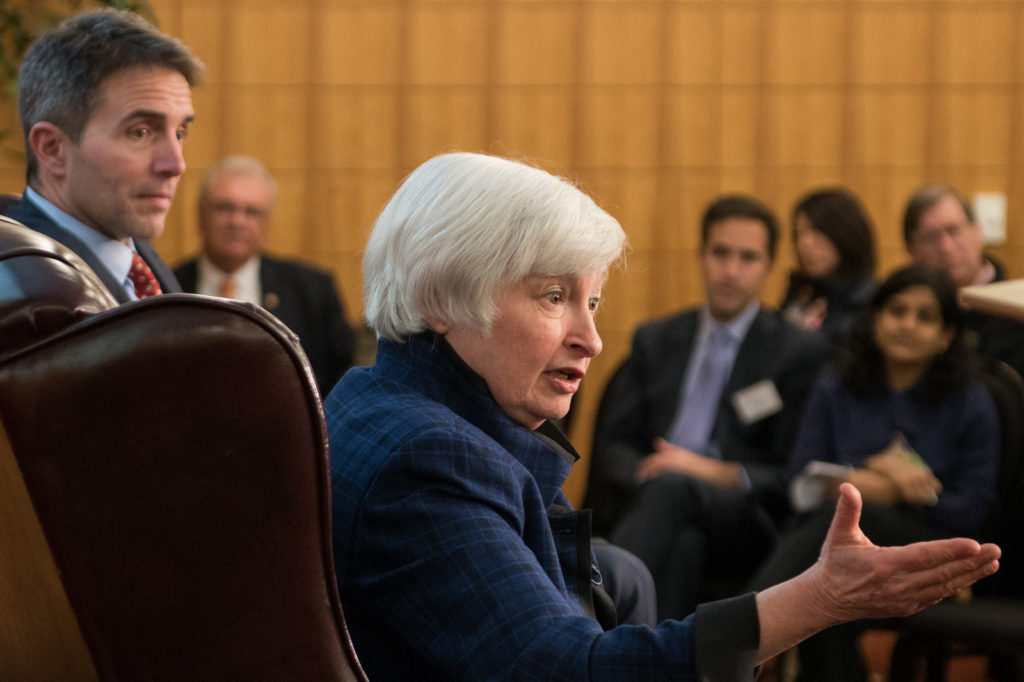At a recent conference in Washington, D.C., former Federal Reserve Chairwoman Janet Yellen told an audience that the debt path the U.S. is going down is “unsustainable,” sparking rumors that the U.S. central bank could tighten “too much” by 2020. Although record levels of taxes have been collected by the federal government, spending has also climbed to the highest in six years.
The U.S. fiscal deficit rose to $779 billion in fiscal 2018, up 17 percent from the previous fiscal year, caused in part by the federal tax overhaul, cutting the corporate tax rate to 21 percent from 35 percent. As well, the omnibus bill signed into law months ago, with a price tag of $1.3 trillion, did not exactly help the fiscal conservative cause.
Yellen said that she is concerned for the future of retirement spending as the “Baby Boomer” generation grows older and nears full retirement, as well as increased levels of healthcare spending on that section of the populous. According to CNBC, the former head of the Fed said, “If I had a magic wand, I would raise taxes and cut retirement spending.”
The federal government is projected to add $985 billion to the federal deficit during fiscal year 2019. This will come about because the government plans to spend over $4.4 trillion dollars, with nearly $400 Billion of that going to service debt that has already accrued over the years. Meanwhile, the U.S. government will be bringing in only $3.42 trillion dollars at current projections.
Nevertheless, some believe that although concern is warranted, a political meltdown is not.
According to the non-partisan Congressional Budget Office’s (CBO) Budget and Economic Outlook: 2018 to 2028, “In CBO’s baseline projections, which incorporate the assumption that current laws governing taxes and spending generally remain unchanged, the federal budget deficit grows substantially over the next few years. Later on, between 2023 and 2028, it stabilizes in relation to the size of the economy, though at a high level by historical standards.”
As Forbes states:
“Think about the United States’ income as Gross Domestic Product (GDP). If you do that, then our debt to income ratio is about one, or equal today. Now if your individual debt to income ratio is one-for-one and you have nothing to show for it (i.e., no hard assets), then you might be in trouble. However, many individuals also have debt three times their income on their primary residence and that may be just fine. Clearly the context and application matter. If the U.S. borrowed to invest in bridges, roads, the military via the G.I. bill, even a social safety net, etc., this should have a beneficial impact on our future income. The problem is that it’s not always immediately clear if the benefits will outweigh the costs. If our debt keeps rising faster than our income, we won’t be able to continue borrowing at the attractive terms we do today. That means government revenue must increase or spending must decrease over time to ensure we remain a trusted borrower.”
If lawmakers look to actually address the federal debt and deficit – that’s Republicans and Democrats – they must recognize that a substantial portion of the projected spending in the future is allocated to social safety nets, like retirement, that will need to be adjusted, including Medicare.
When one considers transfer payments, which are funds dedicated to areas devoid of the production of goods or services returned, projections indicate that by 2040, every dollar of taxpayer-funded government revenue will be allocated to these payments and interest on the debt. Therefore, all of the infrastructure projects, education spending, military funding, job creation initiatives, and many, many other things will play second fiddle to debt repayment.
So, while a political meltdown should not be had now, if something is not done soon to curb the increasing numbers of debt and deficit, the melting will begin in just a few short decades.

